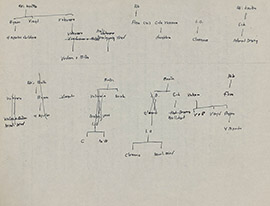Manuscripts Etc.
| CLOSE WINDOW |

|
The following items are drawn from the William Faulkner Foundation Collection at the University of Virginia's |
|
The University of Virginia's Faulkner Foundation Collection contains a wealth of material for students of The Town, including the 500-page typescript that was used as the setting copy by the publishers and the galley proofs in which Faulkner responds to his editor's concerns about discrepancies between this new Snopes novel and the accounts of events and characters that appeared sixteen years earlier in The Hamlet. All the material you see here, however, is from a different item in the Collection: the 154-page typescript that represents an earlier, perhaps even the earliest stage in the evolution of the novel. It's far from complete, but helps us tell two significant stories about the processes - aesthetic and psychological - behind the writing of this second volume in the Snopes trilogy. The 8 pages below enable us to trace the aesthetic story. The first page (top row, far left) is Faulkner's original page 1. Clearly he has already decided on the structure that divides the narrative of Flem Snopes' arrival and career in the town among three different narrators - hence the identification of "CHARLES MALLISON" as the narrator of this chapter. Charles' first paragraphs get Flem into Jefferson in a way that also anticipates the role that "Uncle Gavin" and "V.K. Ratliff" will play as first-person narrators in subsequent chapters. This opening gives every indication that Charles is writing about events that he has witnessed firsthand. The next page below, however, is the new page 1 that Faulkner wrote after he decided while writing the first 3 chapters to shift the story's timeline at least a decade (presumably to make this book's chronology align better the dating in The Hamlet as well as the short stories in which Charles had already appeared), a change that required Faulkner to introduce another of Gavin's young relations - Gowan Stevens, who had disgraced himself in Sanctuary and redeemed himself in Requiem for a Nun - as the source that Charles relies on for his account of Flem's first years in Jefferson. (As if this weren't complicated enough, in this typescript Faulkner numbered the pages in each chapter separately, so each chapter begins with its own page "1." The number in brackets at the top of each linked page identifies the corresponding chapter in the published book.) The original page 1 became page 1-A, and Flem's arrival in town was postponed long enough to explain Gowan's (top row, second from left). |
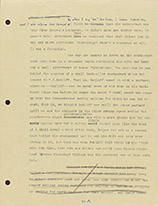 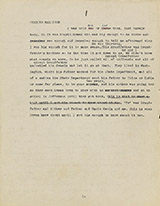 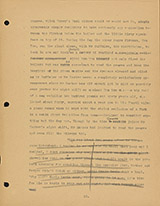 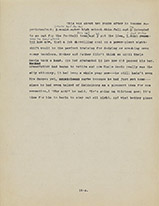
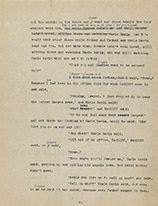 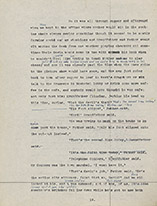 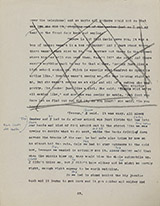 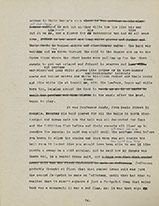 |
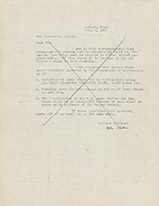 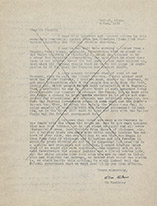 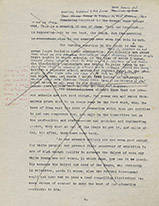 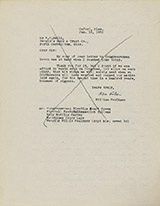 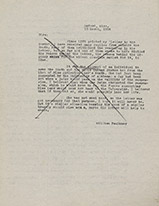 |
|
The central character in the story these versos tell is Faulkner himself, and at the center of the story's plot is his anguish over the issue of race at this moment in U.S. - and specifically Southern - history. Complicated as is the question of Faulkner's own racial politics, what these versos reveal about his anguish over current events almost speaks for itself. The earliest letter (above, far left), to the Memphis Commercial Appeal, was, according to Gregory, written in response to a letter in defense of the Southern status quo by his own brother, John, that the newspaper had printed the day before; drafts of it are on the backs of 3 different typescript pages. Faulkner actually signed all 3, but there's no evidence the letter ever got mailed. The private letter to "Mr Flautt" (second from left) was written in response to another item in the Appeal, about the killing of a Negro in Glendora, Mississippi. "Mr W.C.Neill," the addressee of the third letter (second from right) had first called Faulkner "Weeping Willie" in public in March, 1955. Faulkner seldom used the n-word when writing in his own voice; when he interpolated this letter into his published essay "On Fear," he revised its conclusion as "our native land wrecked and ruined twice in less than a hundred years over the Negro question." His use of the n-word in this private letter will rightly be shocking to us, but I think it also measures the depth of Faulkner's own anguish about the growing civil conflict between the agents of progress - the Federal government, as epitomized by the Supreme Court, and the Civil Rights movement, represented by the National Association for the Advancement of Colored People - and the racist reactionaries in Mississippi and throughout the South who are unwilling to accept change. The final letter here (far right) refers to Faulkner fears about casualties in the escalating conflict: "Miss Autherine Lucy" was the first African American to integrate the University of Alabama; her matriculation in 1956 precipated violent rioting by hundreds of white students. The dates on these and other letters allow us to track Faulkner's writing progress between the end of 1955 and the summer of 1956, when he finished the first draft. For instance, he must have written the draft of Chapter 8 after - but probably not long after - drafting the 10 March 1956 letter about Autherine Lucy. Much more significantly, this material may help us understand why Faulkner is writing this novel at this time. He began writing Flem Snopes' story in the mid-1920s, though he put that novel aside to write Flags in the Dust. A decade later, in a 1938 letter to his editor at Random House, he laid out plans to tell Flem's story as a trilogy, and within two more years followed this with the writing of volume one, The Hamlet (1940). But for the next fifteen years he went no further with Flem's story - until late 1955, when he turned back to it and wrote volumes two and three (The Town and The Mansion) in three and a half years, years in which the South was being convulsed by the historical and moral imperative we call the Civil Rights Movement. If we put the fronts and backs of the pages in this typescript together, side by side, as I've done below, a third story may appear, in the kind of contrapuntal narrative that Faulkner was a master of. It can be summed up by Faulkner himself, in a letter that isn't on the back of any of the typescript pages; writing in December 1955 or January 1956, he tells another of his editors at Random House, Saxe Cummins, that he "Doing a little work on the next Snopes book. . . . Miss[issippi] such an unhappy state to live in now, that I need something like a book to get lost in." |
        |
|
On the front of the first page above, Gavin can take sides with the Negroes who work in the power plant against a common enemy: Flem and Snopesism; if Faulkner read the back of the page before putting it in his typewriter, however, he would have been reminded of how the issue of segregation is driving a wedge between him and his own brother. Front and back of the next pair allow us to compare what V.K. Ratliff calls "the latest Snopes news" with the latest report about the killing in Glendora that Faulkner just read in the newspaper. Front and back of page 19 contrast the adolescent rivalry between Gavin and Manfred de Spain with what Faulkner calls "the burning question in the South"; both pages include handwritten revisions, but the verso's multiple revisions, in pen and pencil, suggest how hard Faulkner is struggling to express himself about current events. On the front side of the last pair, a white and a black boy - Charles and Aleck Sander or Gowan and Top - work together against another outside enemy (De Spain); on the back, Faulkner's dire prediction of the "wreck and ruin" of the South over the racial divide. During these years Faulkner did try in essays and public letters to articulate what he hoped would be a helpful stance on the "burning question" of social change, but by reading both sides of the pages in the typescript we may appreciate how telling the Snopes story gave Faulkner a way to escape not just the present, but the problem of race and racism. At earlier points in his career, in Absalom! and Go Down, Moses, he had used his fiction to confront the 'Southern problem.' By the mid-1950s, however, the question of racial injustice had grown so much more urgent in the world outside Yoknapatawpha that he may have needed his fiction to play a different role. "Just finishing the novel," he wrote his friend and mistress Jean Stein on 22 August 1956. "It breaks my heart," he added, obviously referring to the death of Eula Varner Snopes. But in the summer of 1956, Eula's tragedy may be more bearable than the thought of the "wreck and ruin" of the South, the angst that haunts so many of the letters that are preserved on the versos. The last draft letter in the 154-page typescript, however, written on 11 August, takes on a different kind of current event: the fining of "Mrs Clamroch of Grenada" for bringing a bottle of whiskey into the Mississippi. It takes on some of the same issues as the other letters - war, civic violence, unjust laws - but it expresses pride in at least one white Southern protest. Of course, the protest in support of "Mrs Clamroch" may evoke the protest against "Miss Lucy," and the subtext of Faulkner's hyperbolic willingness to join an imaginary lynch mob may be the real mobs he was so anxious about. There is a possibility that this is all deeply, bleakly ironic - another artistic effect that Faulkner was a master of - and that under the comic tone lurks Faulkner's shame and bitterness as a Southerner. On the other hand, he may here have found in the subject of alcohol a way to recover, at least temporarily, his equanimity. 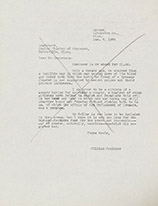 SOURCES: Eileen Gregory, "Faulkner's Typescripts of The Town," Mississippi Quarterly 26 (Summer 1973): 361-86; Joseph Blotner, ed., Selected Letters of William Faulkner; James B. Meriwether, ed., William Faulkner: Essays, Speeches & Public Letters; Michael Millgate, ed., William Faulkner Manuscripts 21, Volume 1: The Town, Miscellaneous Material. Citing this source: |

